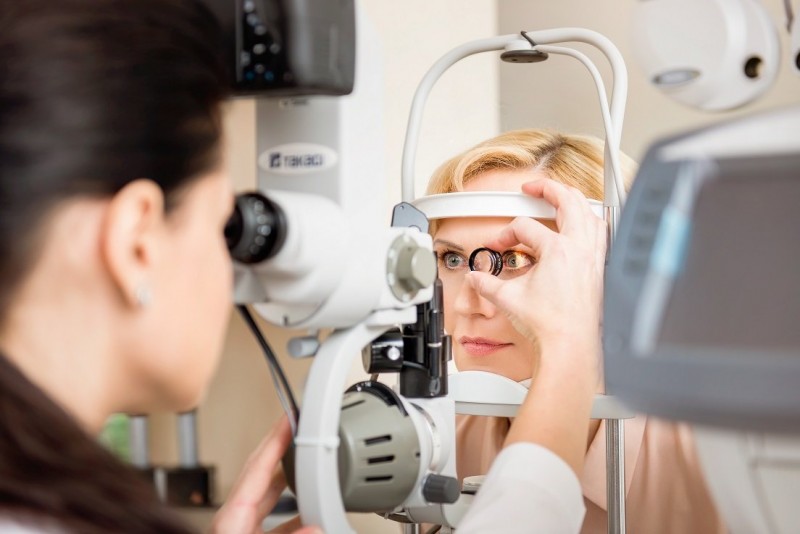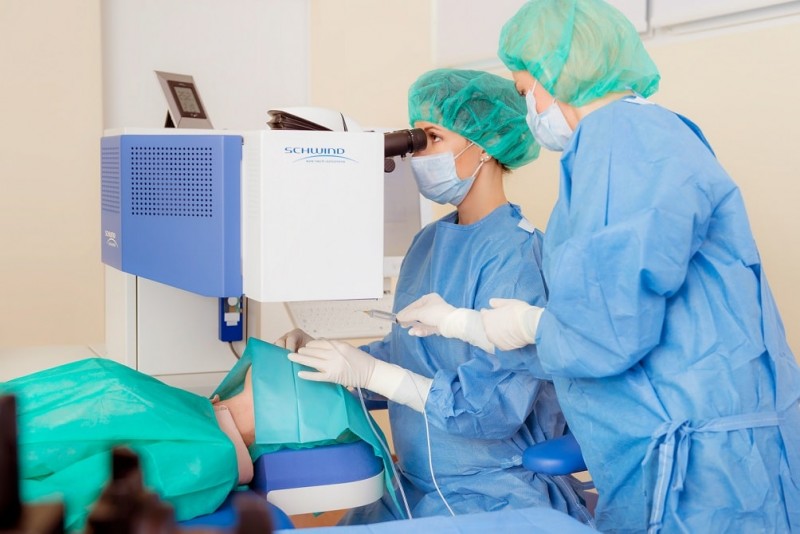2018 02 27
How not to scare away the first kiss: the power of lasers
Eye diseases
8 min. skaitymo

Two faces are slowly nearing each other, the lips are about to touch… and suddenly clink – the glasses are the first to “kiss”. The situation is not so rare, because every third adult has vision problems. The good news is that modern technologies help solve the majority of vision impairments, and the most sophisticated laser SHWIND AMARIS is already available in Lithuania to perform these operations using the SmartSurf method, which is the least damaging to the cornea tissue.
Which vision impairments are treated by laser?
“We use a particularly precise laser to correct short-sightedness, astigmatism, and long-sightedness. The laser is used to adjust the convexity of the cornea to make sure that the flow of light, after passing through the optic system of the eye, is projected precisely on the yellow spot of the retina”, explained Lolita Jotautienė, an ophthalmologist and microsurgeon at the Medical Diagnostic and Treatment Centre situated on Grybo Street in Vilnius. Laser vision correction is recommended for people aged 18–45. This is the most active period in a person’s life. Following a vision correction by laser, people can engage in active sports or enjoy water entertainment without the fear of losing their contact lenses or break their glasses. Laser vision correction is also relevant for young people who intend to choose a profession that requires excellent vision. For example, laser correction helps those entering the Military Academy, future pilots or biathlon athletes recover their vision one hundred per cent. Operations by laser are not performed on children; they start from the age of 18–20 after the individual’s vision stabilises entirely.

“It would not be right to ascribe laser eye corrections to purely beauty operations. It’s true that in the majority of cases the same vision problem can be solved by wearing glasses or contact lenses. However, situations occur where patients cannot tolerate glasses; for instance, if they’re intended for astigmatism correction or for dizziness, it’s difficult for them to climb the stairs. Another case is where eyes see very differently and glasses cannot, therefore, be selected accurately. In such cases, laser vision correction is the only way to give good sight to the patient,” explained ophthalmologist Lolita Jotautienė. When performing vision correction by laser, both eyes can be optimally adjusted considering their condition. Consequently, maximum sight results are obtained. Provided that sufficient thickness of the cornea exists, short-sightedness up to 10 dioptres can be corrected.
“In older age, the ageing processes starts affecting our eyes and the consequences cannot be treated by laser. Following a laser vision correction, older patients will no longer need glasses intended for looking at distances, but the operation will not improve seeing objects that are close to them, and glasses for reading will be still required,” the ophthalmologist said.
Lithuanian doctors operate using SmartSurf, the most modern vision correction method
Laser vision corrections can be performed in one of two ways: surface corneal ablation (PRK, LASEK or the most modern SmartSurf method) or the LASIK method when a flap is formed on the surface of the cornea. The latter is suitable for patients with a sufficiently thick cornea. If the cornea thickness needs to be preserved, surface corneal ablation is recommended.
The majority of vision correction operations globally and in Lithuania have so far been performed using the LASIK method. Following LASIK operations, patients heal and recover their sight quickly. However, the most sophisticated clinics in Germany, Switzerland and other European countries are shifting towards corrections using the most advanced SmartSurf method as it has a lower impact on the cornea.
“Minimal intervention on the cornea is the key advantage of the new method. SmartSurf is the most physiological method that traumatises the cornea the least. The laser removes a layer of the epithelium and, according to data entered by the doctor, polishes the surface of the cornea perfectly smooth. The laser ray works according to the matrix principle across the entire area of the operating surface. It polishes the surface of the cornea especially precisely and evenly both at the centre and at the edges. This guarantees good sight for the patient both by day and by night. During the operation, the doctor touches the eye only to the extent needed to prepare it for the operation and the entire work is carried out by the laser, thus ensuring precision and the removal only of the amount of tissue that is actually necessary,” said the ophthalmologist microsurgeon Lolita Jotautienė, who performs laser corrections at the Medical Diagnostic and Treatment Centre in Vilnius using the SmartSurf method.

The SmartSurf method can be used on patients whose cornea is too thick to operate using the LASIK method. “The doctor decides together with the patient which method of operating should be used. Following a comprehensive examination of the eyes before the operation, the doctor explains to the patient whether it is safe to have a laser vision correction performed, what methods are available, and what are the advantages, disadvantages and risks pertaining to each of them. Sometimes there are no options to choose from, for example when the corneal tissue is insufficient or it is too thin. In such cases, only a surface corneal ablation can be performed, or the operation cannot be performed at all. We have to refuse the operation to 8 per cent of those applying for a laser vision correction because it would not be safe or sufficiently effective,” the ophthalmologist Lolita Jotautienė explained.
When choosing the method of operation, the condition of the eyes, as well as circumstances pertaining to the patient’s lifestyle, are taken into account. For instance, if a young man practices contact martial arts or boxing with a high risk of sustaining a punch directly in the eye, an operation without an incision is recommended. For young women whose cornea is very thin and who in future may have several childbirths, it is also advisable to choose a less invasive SmartSurf vision correction method that impacts the tissue of the cornea the least.
Unique German SHWIND AMARIS laser in Vilnius
The Medical Diagnostic and Treatment Centre is one of the most advanced medical institutions in Lithuania with significant investments in the most innovative medical equipment and the qualifications of its doctors. Three years ago, the centre purchased a modern SHWIND AMARIS laser, intended for vision corrections and enabling it to perform the operations using the SmartSurf method. “The laser performs the task set by the doctor accurately; therefore, a thorough examination before the operation is an essential step that determines the ultimate outcome – the quality of sight. Equipment used for the examination, the competence of the ophthalmologist and, certainly, the laser itself are the guarantors of successful vision correction operations,” Ms Jotautienė said. The German-made SHWIND AMARIS laser has numerous safety mechanisms; it follows the eye movement in five dimensions. If the patient as much as stirs or diverts the eyes, the laser stops at once. The operating surgeon monitors the eye of the patient through a microscope throughout the operation and can stop the laser in case of any inaccuracies. In this way, double control is ensured.
Healing and supervision
Following a laser vision correction, the patient recovers full-rate sight quickly – they can drive a car as soon as the day after a LASIK operation without any glasses, whereas after a SmartSurf vision correction they can get at the wheel in 1–2 weeks, and if necessary the patient can fly the day after the operation, there are no restrictions for this. “However, the patient should visit the operating doctor 3 days after the operation to have an assessment of the healing carried out. The other follow-up examination, subject to the correction method, is scheduled after a month or so,” said the ophthalmologist microsurgeon Lolita Jotautienė, who performs laser vision corrections. Post-operative consulting scheduled by the doctor at the Medical Diagnostic and Treatment Centre is free of charge.
How to choose a suitable time for an operation
Laser vision correction can be carried out all year round. The operation itself takes only 4 minutes (6–7 minutes including the preparation). A week before the examination and operation, it is recommended not to wear contact lenses entirely. All the required tests are performed during a single visit of 1.5–2 hours. Laser vision correction may be performed the day after the consultation. Usually, eye correction operations are carried out at the Medical Diagnostic and Treatment Centre on Fridays. Then, on Monday, the patients should come for a check-up. In extraordinary cases, an examination and operation can be performed on the same day.
People who are allergic to pollen should schedule a laser vision correction date so that at the time of the operation and for at least one month afterwards there are no allergens in their environment and the eyes are not irritated while healing. It is not recommended to have a laser vision correction for pregnant and breastfeeding women. Such operations should be carried out at least six months after nursing ends.
People who cannot imagine their summers without swimming and diving are advised to have a vision correction performed at least one month before their planned vacations. During the healing period, solarium and sauna sessions should be given a pass, the eyes should be protected against bright sunlight, and maximum physical loads should be avoided.








